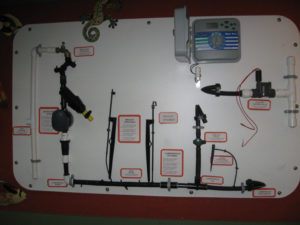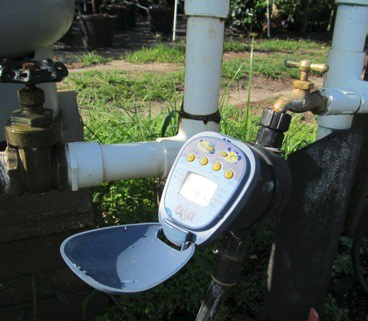 The dog days of summer will soon be upon us. If you’re one of those people that spent most of the last summer desperately trying to stretch another snarled garden hose out to the rapidly wilting impatiens, you probably realized that there has to be a better way. Maybe, you think, it’s time to look into one of those micro sprinkler systems you’ve heard about. Now that you’ve seen the light, here’s what you need to know to get started.
The dog days of summer will soon be upon us. If you’re one of those people that spent most of the last summer desperately trying to stretch another snarled garden hose out to the rapidly wilting impatiens, you probably realized that there has to be a better way. Maybe, you think, it’s time to look into one of those micro sprinkler systems you’ve heard about. Now that you’ve seen the light, here’s what you need to know to get started.
The Basics
 Micro sprinkler irrigation is a system that uses a flexible poly pipe, and various applicators to deliver water easily and efficiently to vegetable gardens, landscape beds, orchards and even potted plants on the patio. Polypipe is used to carry the water to the plants and is easily cut with shears or a utility knife, The fittings used are simply pushed on; no threading poly pipe or gluing required. Polypipe doesn’t need to be buried, so you won’t need to rent a trencher. Simple hand-twist fittings allow the system to hook directly to your hose spigots. Micro sprinklers are available to water everything from hanging baskets on the front porch to row crops out in the vegetable garden. About the only thing micro sprinklers can’t do is lawns; poly pipe system can be an efficient addition to an existing or planned hard-pipe irrigation system. Because lawns and plantings have different water requirements, a hybrid system can save both water and installation
Micro sprinkler irrigation is a system that uses a flexible poly pipe, and various applicators to deliver water easily and efficiently to vegetable gardens, landscape beds, orchards and even potted plants on the patio. Polypipe is used to carry the water to the plants and is easily cut with shears or a utility knife, The fittings used are simply pushed on; no threading poly pipe or gluing required. Polypipe doesn’t need to be buried, so you won’t need to rent a trencher. Simple hand-twist fittings allow the system to hook directly to your hose spigots. Micro sprinklers are available to water everything from hanging baskets on the front porch to row crops out in the vegetable garden. About the only thing micro sprinklers can’t do is lawns; poly pipe system can be an efficient addition to an existing or planned hard-pipe irrigation system. Because lawns and plantings have different water requirements, a hybrid system can save both water and installation
dollars.
Getting Started
 First, determine what needs to be irrigated. From window boxes to flowerbeds to garden plots, hedgerows to orchards to prized specimen trees, what needs water? Next, make a sketch. It needn’t be architect grade; just show relative positions and approximate distances; usually, drawing on a copy of your site plan works fine. Be sure to mark the positions of spigots and any hardscape features such as buildings, driveways, and sidewalks.
First, determine what needs to be irrigated. From window boxes to flowerbeds to garden plots, hedgerows to orchards to prized specimen trees, what needs water? Next, make a sketch. It needn’t be architect grade; just show relative positions and approximate distances; usually, drawing on a copy of your site plan works fine. Be sure to mark the positions of spigots and any hardscape features such as buildings, driveways, and sidewalks.
Design the system
Now, draw in a poly pipe from a spigot to everywhere you want to get water. This is the creative part! Remember, the pipe is flexible; it tends to lay out in sinuous curves. Let it; try to get the pipe within about six feet of everything that needs water. It’s ok to cross lawn areas; you can use an edger to make a small cut to get the poly pipe out of harm’s way. A few rules of thumb: you can run about six hundred feet of three-quarter inch poly pipe per spigot. Above that, you’ll have to split the system into zones. Often, the driveway naturally splits the yard into two zones. For larger or more intensively planted lots, there may be six or more zones. Plan to water no more than 20 trees, or 50 shrubs or 200 square foot of perennial or annual beds per zone. Use tees to add branch lines out to isolated plants or island beds. Now measure out how much poly pipe you need, and count up the number of zone-heads, tees, and end caps…this is your mainline parts list. Now it’s time to pick your emitters…
Emitters
Or everything you ever wanted to know about micro sprinklers…Micro sprinklers actually range from really micro to practically macro.
 The really micro end of the scale starts with drippers. These tiny emitters are inserted into the poly pipe, and literally drip, emitting from ½ to 2 gallons per hour drop by drop. A few feet of spaghetti tube can be used to direct the drips into a pot or to the base of a small plant. Drippers work best for containers, or in beds with really good soil. In sandy conditions, drippers tend to wet too small an area to be effective.
The really micro end of the scale starts with drippers. These tiny emitters are inserted into the poly pipe, and literally drip, emitting from ½ to 2 gallons per hour drop by drop. A few feet of spaghetti tube can be used to direct the drips into a pot or to the base of a small plant. Drippers work best for containers, or in beds with really good soil. In sandy conditions, drippers tend to wet too small an area to be effective.
 Next up the scale are vortex sprayers; these tiny sprinklers throw a flat circle of water, adjustable up to about a six-foot diameter. Vortexes are great for larger containers,  shrubs. or large vegetable plants like tomatoes and peppers. They are especially good for keeping foliage dry, a benefit with plants that can be prone to leaf fungi.
Next up the scale are vortex sprayers; these tiny sprinklers throw a flat circle of water, adjustable up to about a six-foot diameter. Vortexes are great for larger containers,  shrubs. or large vegetable plants like tomatoes and peppers. They are especially good for keeping foliage dry, a benefit with plants that can be prone to leaf fungi.
 At the macro end of micro sprinklers are Maxijets. These larger, stake mounted sprinklers can water up to a 12-foot circle and are adjustable both in distance and arc. Half-circle emitters are great for keeping water off of paths and sidewalks, and narrow strip patterns work well for row crops. Maxijets are best for watering larger areas, and thickly planted annual or perennial beds. Specialty emitters for vineyards, hanging baskets, and other applications are available as well. So figure out how many of each type you will need, add that to your parts list. If you still aren’t sure how to get it laid out well or need help with your design, just bring us a drawing of your yard and we’ll help you get it right.Â
At the macro end of micro sprinklers are Maxijets. These larger, stake mounted sprinklers can water up to a 12-foot circle and are adjustable both in distance and arc. Half-circle emitters are great for keeping water off of paths and sidewalks, and narrow strip patterns work well for row crops. Maxijets are best for watering larger areas, and thickly planted annual or perennial beds. Specialty emitters for vineyards, hanging baskets, and other applications are available as well. So figure out how many of each type you will need, add that to your parts list. If you still aren’t sure how to get it laid out well or need help with your design, just bring us a drawing of your yard and we’ll help you get it right.Â
 The true beauty of a micro sprinkler system is its flexibility. We have had customers adapt their systems to provide cooling mists for horses and dogs, or to automatically keep bird baths filled. A simple battery-operated clock will take the chore out of turning on the water. Once you are freed from the tyranny of dragging hoses, you’ll be amazed at how much more fun gardening really is!
The true beauty of a micro sprinkler system is its flexibility. We have had customers adapt their systems to provide cooling mists for horses and dogs, or to automatically keep bird baths filled. A simple battery-operated clock will take the chore out of turning on the water. Once you are freed from the tyranny of dragging hoses, you’ll be amazed at how much more fun gardening really is!

